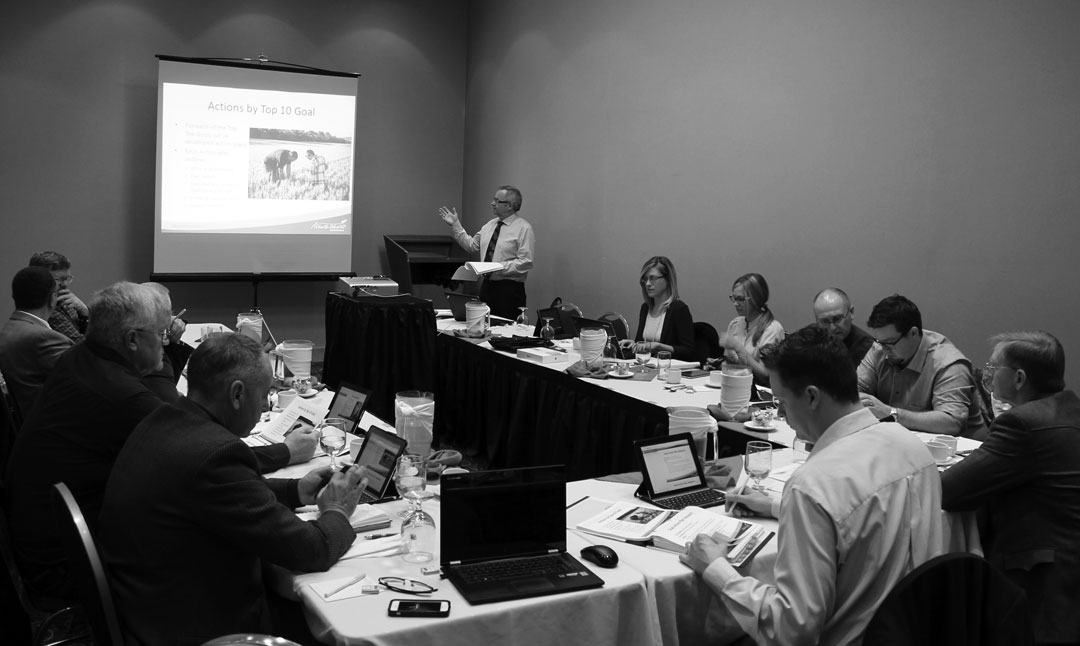THE VALUE OF CHECK-OFFS
LEVIES REAP BIG REWARDS FOR FARMERS
BY TREVOR BACQUE
If you have ever wondered where that great new variety growing in your field came from or how the latest international trade deal came about, you can often look to provincial crop commissions as the significant drivers of these successes.
In Alberta, $1 and $0.70 are collected when you sell one tonne of your barley and wheat, respectively. From there, Alberta Barley and the Alberta Wheat Commission’s boards of directors (both farmer-elected) meet and discuss how best to utilize producer dollars.
Next, the funds are allocated to a carefully selected pool of research, market development, policy, communication and extension projects that have one aim in mind—boosting the bottom line of Alberta’s barley and wheat farmers.
“When we are tasked with investing farmer dollars, it’s crucial we talk about this as a board of directors to ensure we invest strategically,” said Kent Erickson, AWC chairman and region three director.
Erickson, who farms near Irma, said the organization’s check-off dollars have helped put Alberta’s quality wheat on the map outside of Canada. “Areas all over the world, including Asia, the Middle East-North Africa region, South America and parts of Europe, are well-versed in the quality that comes from both Canada and Alberta because we are sending representatives to those areas each year, including this past winter,” he said.
Erickson knows that by leaving his check-off with the commissions, he’s multiplying his money. It’s estimated one check-off dollar turns into a $20.40 return for wheat and $7.56 for barley when it comes to research investment, according to a University of Saskatchewan study.
“When we receive farmer check-offs, we work with fellow commissions, industry groups, and the government to leverage money. These partnerships ultimately help give Alberta farmers access to premium varieties that are yield champions and have better everything—whether it’s disease and lodging resistance, better milling quality or straw strength.”
AWC invests $1.7 million annually on research aimed at improving the profitability of Alberta wheat farmers and in 2015 launched a groundbreaking 4-P partnership with Agriculture and Agri-Food Canada (AAFC) and Canterra Seeds to bring new Canada Prairie Spring Red varieties to market.
In addition, commission staff members do their part to maximize producer dollars by working together on research, policy and market development initiatives.
Initiatives led by the management teams are often collaborative amongst commissions. Alberta Barley and AWC share an office space, which makes working together that much easier.
One of the key successes of the commissions’ joint activities has been the recent Team Alberta lobby mission in Ottawa. Staff and board members met with all political parties, outlining key priorities to ensure Alberta farmers’ voices are heard loud and clear in the nation’s capital—communicating what is important back at the farm gate. The ACE program, Alberta Crops Extension, is another ongoing collaboration run in part by all four crops commissions (including the Alberta Pulse Growers Commission (APG) and the Alberta Canola Producers Commission) to host crop walks and maintain extension work for farmers.
“When you have as many initiatives as we do at Alberta Barley, it makes our voice that much stronger when we can strategically partner with other groups in the industry,” said Mike Ammeter, chairman of Alberta Barley and region three director-at-large. Ammeter and his wife Allison (APG chair) farm near Sylvan Lake in Central Alberta.
“If you try to go it alone in agriculture, it’s too big of a nut to crack on your own,” said Ammeter. “You’re better off working with other people. As you combine ideas and research, crossover becomes invaluable.”
Ammeter has seen the volume of work a group faces when it branches out on its own, and sees the truth in the “many hands make light work” mantra, especially in agriculture policy, market development and research.
In addition to the work that the two commissions do on behalf of their farmer members, the Western Wheat and Barley Check-off (WWBC), also known as the Western Canadian Deduction, is also managed in house by the accounting staff— for a fee—saving producers administrative overhead by centralizing operations.
The WWBC is a temporary, five-year transitional program initiated by the federal government and administered by Alberta Barley. The program will remain in place while western Canadian provincial wheat and barley commissions transition into new research and market development models.
Levies are collected from the WWBC across the Prairies and shown on a farmer’s cash purchase ticket at the point of sale from Canadian Grain Commission-licensed grain buyers, and the funds are distributed to well-known western Canadian organizations: the Western Grains Research Foundation (WGRF) at $0.30 a tonne for wheat and $0.50 a tonne for barley from Saskatchewan and Manitoba, and separate funding to the Field Crop Development Centre at Lacombe from Alberta Barley, the Canadian International Grains Institute (Cigi) at $0.15 a tonne for wheat and the Canadian Malting Barley Technical Centre (CMBTC) at $0.03 a tonne for barley.
More than 200 varieties have been created since 1995 through WWBC funding, giving farmers the competitive edge they need in world markets.
“The WWBC is a great example of us being masters of our own destiny,” Ammeter said of the recipient groups. “Things don’t just fall from the sky. Markets don’t just appear and you do not simply find new varieties growing in the back 40 overnight.”
Ammeter pointed to competition on a global grain scale to underline his belief in “beating the street” to bring awareness and interest to Alberta’s—and Canada’s—top-quality products, done in part by the crop commissions pushing the local agriculture agenda forward. The levy ensures work is carried out to develop new, profitable varieties, as well as to promote cereals around the world and develop new markets for western Canadian farmers.
“One of the reasons Alberta’s grain and farming practices are recognized is because of the hard work the commissions do on behalf of farmers,” said Erickson. “Without them, we’d be lost.”







Comments